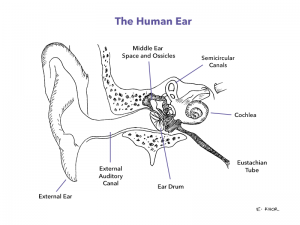Hearing Loss

Sound passes down the ear canal to reach the eardrum. The sound waves then move the eardrum in and out. There are three bones called the Malleus, Incus and Stapes (ossicles) that connect the eardrum across the middle ear space to the inner ear (cochlea). Within the cochlea the sound waves are converted to nerve impulses that carry the sound to the auditory centres of the brain.
Hearing losses can result from problems anywhere along this pathway. There are two main types of hearing losses.
1) Conductive Hearing Loss (CHL)
CHL occurs with any problem that prevents conduction of sound to the cochlea including;
- Fluid in the middle ear
- Blockages of the ear canal
- Damage to the eardrum and/or ossicles
- Otosclerosis and Cholesteotoma are less frequent causes.
The overall hearing loss is usually only mild to moderate. Treatment depends on the underlying cause and frequently can be improved with surgical intervention.
If the cause can't be reversed then most people will do very well with a conventional hearing aid. In certain situations implanted bone conduction hearing aids can also be considered.
2) Sensori-neural hearing loss (SNHL)
Sensori-neural hearing losses occur with disorders that affect the cochlea or the nerve from the cochlea to the brain. There are many causes of SNHL. Some of the more common ones include;
- Age (presbycusis = age related HL)
- Noise exposure
- Some drugs
- Meniere’s syndrome
- Tumour, usually benign.
- Autoimmune diseases
There are many other rarer causes.
Rapidly progressive, sudden or asymmetrical SNHL needs investigation.
SNHL range from the very mild to complete hearing loss. Most mild to moderate cases do very well with conventional hearing aids. More severe cases my benefit from Cochlear implantation.